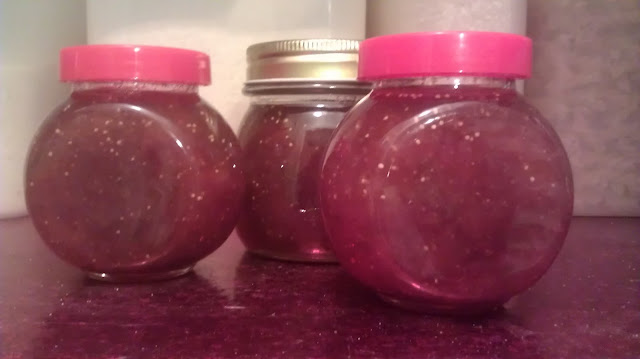 |
| Not a very big tree, but very fruitful! |
 |
| Fig cake (before baking) |
Last year the leaves of the fig tree were heavily affected with scale and we had to spray with white oil.
There were always lots of ants feeding off the sweet honeydew produced by the scale, and this weakens the tree eventually.
This year I examined the leaves closely every couple of days and managed to pick a few leaves with scale and just cut them out and threw them in the rubbish. Apart from that a couple of times I saw some sort of beetle eating the ripe figs that were opened. Those figs would go straight into the rubbish bin by the driveway, although some of the beetles managed to fly away!
Well, enough about the nasty bugs, let me give you the recipe for the fig jam.
This time I added rosemary to the original jam recipe and it was the best ever (so said my husband)!

There were always lots of ants feeding off the sweet honeydew produced by the scale, and this weakens the tree eventually.
This year I examined the leaves closely every couple of days and managed to pick a few leaves with scale and just cut them out and threw them in the rubbish. Apart from that a couple of times I saw some sort of beetle eating the ripe figs that were opened. Those figs would go straight into the rubbish bin by the driveway, although some of the beetles managed to fly away!
 |
| A beetle on a fig |
This time I added rosemary to the original jam recipe and it was the best ever (so said my husband)!

Ingredients
1000kg figs
700gr sugar
1/4 cup lemon juice
1/4 cup Port wine or Muscat wine (sweet wine)
1 cinnamon stick or 1 tablespoon cinnamon powder
1 stick or two of rosemary (optional)
A handful of walnuts, toasted and sliced (optional)
Slice the tops of the figs and cut them into small pieces, add lemon juice, cinnamon, rosemary and cover with the sugar and let sit until the sugar dissolves.
Slowly bring the mixture to a boil in a moderate setting, stirring occasionally, during about 20 minutes until the fruit is soft and the liquid is thick. Let it cook for 1 hour in very low heat. Remove the cinnamon stick and rosemary. Add the toasted walnuts
Let cool and pour into sterilized glass jars and refrigerate. Consume within 3 months.

1000kg figs
700gr sugar
1/4 cup lemon juice
1/4 cup Port wine or Muscat wine (sweet wine)
1 cinnamon stick or 1 tablespoon cinnamon powder
1 stick or two of rosemary (optional)
A handful of walnuts, toasted and sliced (optional)
Slice the tops of the figs and cut them into small pieces, add lemon juice, cinnamon, rosemary and cover with the sugar and let sit until the sugar dissolves.
Slowly bring the mixture to a boil in a moderate setting, stirring occasionally, during about 20 minutes until the fruit is soft and the liquid is thick. Let it cook for 1 hour in very low heat. Remove the cinnamon stick and rosemary. Add the toasted walnuts
Let cool and pour into sterilized glass jars and refrigerate. Consume within 3 months.

As I used a sprig of Rosemary from our old woody bush, all the leaves broke away and at the end of the cooking when I tasted the jam the rosemary leaves were still woody, so I had to pick all of them out of the pot with a pair of tweezers! What a job that was!
Still the taste is great, so if want to use rosemary put it in a muslin or calico cooking bag, it won't break away and you won't have to pick out the leaves with tweezers.
If you are lucky enough to have figs in your garden or can buy them cheap, try this out, you won't regret it.
I'm now looking forward to baking some lovely things with passion-fruit, yesterday I picked the first two that had fallen from the climber that was planted last year and the vine is packed with fruit.
Still the taste is great, so if want to use rosemary put it in a muslin or calico cooking bag, it won't break away and you won't have to pick out the leaves with tweezers.
If you are lucky enough to have figs in your garden or can buy them cheap, try this out, you won't regret it.
I'm now looking forward to baking some lovely things with passion-fruit, yesterday I picked the first two that had fallen from the climber that was planted last year and the vine is packed with fruit.
 |
| Passion fruit |































